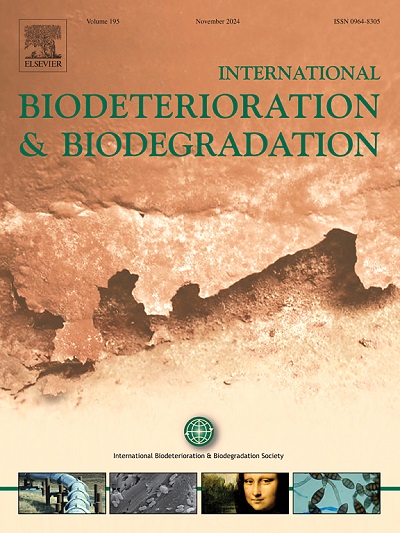Assessing the impact of agrifood byproduct-based bioplastics on soil microbial communities and functioning
IF 4.1
2区 环境科学与生态学
Q2 BIOTECHNOLOGY & APPLIED MICROBIOLOGY
International Biodeterioration & Biodegradation
Pub Date : 2025-04-18
DOI:10.1016/j.ibiod.2025.106083
引用次数: 0
Abstract
The environmental burden of plastic pollution has driven the search for sustainable alternatives, such as biodegradable bioplastics derived from agrifood byproducts, which hold the potential for addressing global waste management challenges. Given the close relationship between the biodegradability of biopolymers and soil microbial activities, it is vital to understand how the presence of novel bioplastics affects their function and structure. This study assessed microbial responses to different plastics: potato starch-based bioplastic, locust bean-based bioplastic, and non-biodegradable polyamide-polyethylene plastic in natural sandy-loam soil (LUFA 2.2). Soil without any (bio)plastics was used as a control. Despite initial pronounced differences in defragmentation rates between the two types of bioplastics, only 10 and 20 % w/w of the fragments were recovered after 17 weeks. The type of bioplastic influenced the fungal colonization pattern, with potato starch-based bioplastic resulting in more isolated fungal species than locust bean-based bioplastic. The soil dehydrogenase response was inconsistent, while β-glucosidase activity showed an initial increase in both bioplastic treatments, with a sustained stimulation only in potato starch-based bioplastic. β-glucosidase activity coincided with higher carbon substrate consumption maintained by the end of the 17 weeks of exposure, indicating more dynamic changes in microbial functions in potato starch-based bioplastic. Decreased carbon substrate consumption was observed in non-biodegradable polyamide-polyethylene plastic. The current study represents a first screening approach for the impact of applying agrifood byproducts as novel biopolymers directly in the soil, demonstrating their distinct effects without any pronounced adverse effects on soil microbiota compared to conventional polyamide-polyethylene plastic.

评估农业食品副产品生物塑料对土壤微生物群落和功能的影响
塑料污染造成的环境负担促使人们寻找可持续的替代品,例如从农产品副产品中提取的可生物降解生物塑料,这有可能解决全球废物管理挑战。鉴于生物聚合物的生物降解性与土壤微生物活动之间的密切关系,了解新型生物塑料的存在如何影响其功能和结构至关重要。本研究评估了微生物对天然砂壤土中不同塑料的反应:马铃薯淀粉基生物塑料、刺槐豆基生物塑料和不可生物降解的聚酰胺-聚乙烯塑料(LUFA 2.2)。不含任何(生物)塑料的土壤作为对照。尽管最初两种生物塑料的碎片整理率明显不同,但17周后只有10%和20%的碎片被回收。生物塑料的类型影响真菌的定植模式,马铃薯淀粉基生物塑料比刺槐豆基生物塑料产生更多的分离真菌物种。土壤脱氢酶的响应不一致,而β-葡萄糖苷酶活性在两种生物塑料处理中都表现出初始增加,只有马铃薯淀粉基生物塑料持续刺激。β-葡萄糖苷酶活性与马铃薯淀粉基生物塑料中微生物功能的动态变化相吻合,这表明马铃薯淀粉基生物塑料中的微生物功能在17周后保持较高的碳底物消耗。在不可生物降解的聚酰胺-聚乙烯塑料中观察到碳基消耗减少。目前的研究代表了对农业食品副产品作为新型生物聚合物直接在土壤中施用的影响的首次筛选方法,与传统的聚酰胺-聚乙烯塑料相比,证明了它们的独特效果,对土壤微生物群没有任何明显的不利影响。
本文章由计算机程序翻译,如有差异,请以英文原文为准。
求助全文
约1分钟内获得全文
求助全文
来源期刊
CiteScore
9.60
自引率
10.40%
发文量
107
审稿时长
21 days
期刊介绍:
International Biodeterioration and Biodegradation publishes original research papers and reviews on the biological causes of deterioration or degradation.

 求助内容:
求助内容: 应助结果提醒方式:
应助结果提醒方式:


